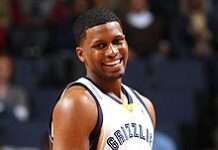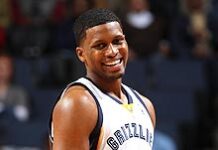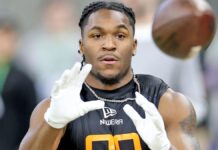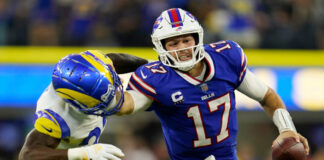The Pasadena Millionaires Baseball Club was losing games, fans and especially money, and its nickname soon became a mockery.
Team officials finally concluded, midway through its Class D minor league season of 1913, that the grass was greener 100 miles up the coast.
This is how the first professional sports franchise arrived in Santa Barbara 99 years ago. The team, which renamed itself the “Barbareans,” played more than a week of road games before making its local debut on June 24, 1913.
By July 23, with Santa Barbara leading the second-half standings, the old Southern California Trolley League pulled that greener rug out from under the team and abruptly ceased operations.
The Barbareans lasted only 40 days and 40 nights — and there was no Noah’s Ark to ship them off to a sunnier situation.


Peter Moore, founding investor of the Santa Barbara Sky Football Club, was honored by the English Premier League as its CEO of the Year in 2019 for his work with Liverpool FC. (Santa Barbara Sky Football Club photo)
It’s an old story that’s been replayed in Santa Barbara many times the last century, in sports ranging from baseball to volleyball to basketball to soccer. If you’d gotten a nickel for every failed attempt here, you might have enough to succeed with your own pro venture.
But that’s why Peter Moore has a sporting chance as a founding investor with the newly created Santa Barbara Sky Football Club. He’s got plenty of nickels, having already forked out $5 million in franchise fees to the United Soccer League to field teams on both its men’s and women’s circuits.
They are expected to play their first matches at Santa Barbara City College’s seaside, 10,000-seat La Playa Stadium in 2024.
Moore earned his money as a video game executive and his promotional chops as Reebok’s vice president of global sports marketing.
“I’m happy I’m in a position now to be able to give back to a community that has welcomed me and my family so much over the last 18 months,” he said before launching Sky FC with a rooftop gathering last week at MOXI, The Wolf Museum of Exploration + Innovation.
“I’ve made a few dollars in my life, and now I’ve got the opportunity to give back and use the lessons that I’ve learned,” he added. “I was president of EA Sports, so I built (the video soccer game) FIFA. We’re excited about what we can do here.”
Moore has already shown his own moxie, exploring the community he now calls home with a keen eye while scheming innovative ways to make his venture work.
Pro soccer has failed twice in Santa Barbara. The Santa Barbara Condors lasted only half the 1977 season in the American Soccer League while Real Santa Barbara, which debuted in the Western Soccer Alliance in 1989, lasted only one more season after switching to the American Professional Soccer League.
The old-timers have educated Moore in all the cautionary tales. His conclusion?
“This is not the Condors.”
“The old ASL had probably 10 people running the league,” he told Noozhawk. “This a different time, a different place, a different league. As somebody who first arrived here in the ’70s when it was often called a communist sport, the American mentality and openness to soccer has changed.
“You just saw Apple pay $2.5 billion for Apple TV streaming rights for (Major League Soccer) MLS. The game is in a completely different place.”
Moore, a native of England, came to the United States in the 1970s to play pro soccer and earn a master’s degree at Long Beach State. His star in the American business world rose to celestial heights during the four decades that followed.
He was lured back to both his roots and the sport of soccer when his hometown Liverpool FC recruited him to serve as its CEO in 2017. Two years later, the English Premier League named him its CEO of the Year
Moore stepped down during the COVID-19 pause of 2020, and moved to Montecito. He’s spent the last 18 months monitoring the pulse of his new community and brainstorming its return to minor league soccer.
“Several months ago, when we were starting to formulate our plans, I brought all the movers and shakers to my home,” he said. “We spent an evening with them, going through our plans and listening to them … Learning about the history and the challenges, and what’s been here before and what has fallen down.”
Here is the chonological roll call the pro sports that have fallen in Santa Barbara during the last century:
Baseball: 1913, 1941-1942, 1946-1955, 1962-1967
The national pastime has had more starts and stops in Santa Barbara than a junkyard jalopy chugging up San Marcos Pass. The Barbareans barely got rolling despite such marketing ploys as the employment of a silent-film actor as one of its coaches.
Bull Durham, a former major league pitcher who’d been working for the newly arrived American Film Manufacturing Co., better known as Flying A Studios, shared managing duties with Spencer Abbott and John Schuster.
Durham had changed his name a decade or two earlier, borrowing it from a tobacco brand, so he could sneak back into professional baseball. He’d previously been banned for his involvement in a barroom brawl.
Eight decades later, Santa Barbara native Ron Shelton would borrow the Bull Durham name for the title of a baseball film that was ranked by Sports Illustrated as “the greatest sports movie of all-time.”
It took Santa Barbara another 28 years to take its next swing at minor league baseball. The construction of Laguna Park in 1938 convinced civic leaders to organize an unaffiliated team called the Saints and join the California League in 1941.


The 1948 Santa Barbara Dodgers won the California League playoffs by defeating the Stockton Ports, 4-3, in the championship series. (Santa Barbara Dodgers photo)
More than 44,000 fans turned out that first season, convincing the Brooklyn Dodgers to take over the lease at Laguna and bring their own Class C farm club to town the following year.
A Japanese submarine gummed up the works by lobbing 28 shells into the Ellwood oil fields west of Santa Barbara in February 1942. Although the Santa Barbara Dodgers won the Cal League that summer, blackout regulations and gasoline rationing forced them to shut down for the remaining three years of World War II.
Minor league baseball returned to Laguna Park with a flourish in 1946. The Dodgers set the California League attendance record the following year with 92,541 in paid admissions.
The arrival of television, however, soon sapped the local team of its fans. Only 43,000 showed up in 1950, and attendance bottomed out at 29,000 in 1953. The Dodgers responded by moving the farm club to Bakersfield.
Local officials kept their hand in minor league baseball by organizing an unaffiliated team called the Channel Cities Oilers. They split their home games between Santa Barbara and Ventura, however — and divided they soon fell. The Oilers were averaging barely 200 fans a game when they decided to move to Reno midway through the 1955 season.
The expansion New York Mets brought baseball back to Santa Barbara in 1962 with a minor league team called the Rancheros. The Dodgers, jealous that a National League rival had taken up residence with their ex, reclaimed the lease at Laguna Park in 1963.
They got a cold shoulder from several foggy summers, however. Dwindling attendance and about $100,000 in red ink prompted them to jilt Santa Barbara for Bakersfield once again after the 1967 season.
City officials preempted any chance for a reconciliation by tearing down Laguna Park in 1970 and replacing it with a vehicle maintenance yard, office bungalows and low-income housing at the 5½-acre site.
Their promise to replace it with a new municipal ballpark proved an empty one, and Santa Barbara has now gone more than a half-century without professional baseball.
Indoor Volleyball, 1975-1980
The Santa Barbara Spikers were a charter member and cornerstone of the International Volleyball Association. They won the 1978 championship behind Brazilian setter Bebeto de Freitas, their player-coach and the league’s Male MVP. Defensive whiz Rosie Wegrich won the Female MVP award.


Members of the 1979 Santa Barbara Spikers pro volleyball team were, clockwise from left, Peter Stefaniuk, Reede Reynolds, Luiz Eymard, Larry Milliken, Luiz Fernando, Bebeto de Freitas, Melody Parker, Rosie Wegrich and Sue Herrington. (Santa Barbara Spikers photo)
Sue Herrington quit UC Santa Barbara’s fledgling women’s program to join the Spikers without having to take a step out of the familiar confines of Robertson Gym.
But the Spikers changed owners as often as their gym socks. Local businessman Bill Levy came to the rescue as their final owner. He saw the writing on the Rob Gym wall, however, when the San José Diablos halted operations on June 11, 1980. He tried to sell the team to Don Moger a day later.
The IVA spiked the deal, however, when it learned that Moger had booked the team for an immediate move to Los Angeles. Levy soon washed his hands of the whole affair by withdrawing his financial support.
The Spikers played their last match on June 17, 1980. The Albuquerque Lasers also halted operations that week, and the IVA’s entire house of cards collapsed soon after.
Spikers’ alumni continued to contribute mightily to local volleyball, though. Jon Lee, who played for the team in its first season of 1975, became a Santa Barbara Athletic Round Table Hall of Fame coach and teacher at San Marcos High School.
Melody Parker, a member of the 1978 championship team, became the first woman to serve as head coach of a California community college men’s volleyball team when Santa Barbara City College hired her in 1996. She guided the Vaqueros to 10 state playoff appearances, advancing to the Final Four five times, during her 13 seasons at the helm.
Nobody took a more interesting career path after the Spikers than Larry “Boomer” Milliken, another stalwart for the 1978 IVA champions. He coached at UCSB for a couple of decades, helping Ken Preston take the Gauchos to the 1988 NCAA Men’s Volleyball Final.
He also served as a tennis umpire at the U.S. Open during the 1990s, and even helped coach Duende to a Pacific Coast Open polo championship during the 2000s.
Soccer, 1977, 1989-1990
Having a Liverpool man revive pro soccer in Santa Barbara comes with an ironical kicker: The first attempt in 1977 included the marquee name of Ron Yeats, a former Liverpool FC star from Scotland, as player-coach of the newly formed Condors.
General manager Dave Whiteside added four other British pros to his lineup. He augmented his roster with local talent such as former Santa Barbara High and Westmont College star Alfonso Guzman and three other ex-Warriors: Jean Paul Verhees, Dan Ribbens and Lloyd Gay. Former UCSB stars Refugio “Cam” Camarena and Joe Lima were also signed.
The team had a promising debut on April 25, playing the Sacramento Spirit on the road to a 1-1 draw. The Condors returned home to draw 2,000 fans to their debut at San Marcos High’s Valley Stadium. They were breaking even with a 4-4-4 record by the midpoint of the ASL season.


Rudy Ybarra, a two-time CIF-Southern Section Player of the Year for Santa Barbara High, was voted as the North American Soccer League’s Rookie of the Year in 1978 while playing for the Los Angeles Aztecs. He completed his playing career with Real Santa Barbara in 1989 before continuing on to an award-winning coaching career. (Real Santa Barbara photo)
But they were also quickly breaking the bank. The Condors’ financial problems became public when several players complained that they weren’t getting paid. A landscaper added a lawsuit to the team’s woes, claiming he was owed $21,000 for his work on the field.
The club had incurred too much debt and ill will by the time ASL officials got involved. They announced the Condors’ extinction after a 1-0 home defeat to the Spirits on June 25.
Real Santa Barbara, which played its home games at SBCC, went just 5-11 during its maiden season of 1989. Its roster included a pair of local stars who would become champion coaches: Santa Barbara High legend Rudy Ybarra, who was in his final season as a pro at age 31, and UCSB alum Tim Vom Steeg.
The team had more success the following year under Valery Volostnykh, a disciplinarian and the first Soviet to ever coach in an American soccer league. Real Santa Barbara took second in the APSL with a 9-7 record after he instituted a strict training regimen.
“They were in not good physical condition,” Volostnykh said at the time. “I increase their physical condition. That is first most important thing. In the beginning, the players did not like.”
He even cleaned up their language on the pitch.
“I don’t like those (curse) words,” he told reporters. “If you use them in the Soviet Union, the first time is a 25 rubles fine, then you are suspended.”
The team had gone through 40 players by the time the season ended.
“The players who understood his ways stuck it out,” said team captain Alex Basso, a veteran forward.
But Real Santa Barbara’s financial fitness wasn’t as healthy. It couldn’t even afford to rent a training field.
“We don’t even know where we’re going to practice from day to day,” Basso said. “Sometimes we just go to a tennis court and kick the ball over the net.”
By season’s end, it was game, set and match for Real Santa Barbara.
Basketball, 1989-1990, 2007-2016
The Santa Barbara Islanders came and went in a flash, which was just how they played the game of basketball. Head coach Sonny Allen and assistant Don Ford had them running full tilt to lead the Continental Basketball Association in scoring for much of the 1989-1990 season.


Derrick Gervin played for the NBA’s New Jersey Nets after leading the CBA with a 31.7-point scoring average for the 1989-1990 Santa Barbara Islanders. (Continental Basketball Association photo)
Forward Derrick Gervin averaged a league-best 31.7 points per game while guard Luther Burks scored at a 23.3-point clip. Leon Wood, who had helped the United States win a gold medal at the 1984 Olympic Games in Los Angeles, was the CBA’s third-leading assist man.
But it was Jim Les, now the head coach at UC Davis, who set the league record when he handed out 24 assists in playoff win against Tulsa.
The team won the Western Division of the CBA’s National Conference with a 37-19 record, advancing to the conference finals before losing to Rapid City, South Dakota.
But the Islanders lost money as quickly as they ran the court. By season’s end, investors had reportedly lost $610,000.
Local auto dealer Howard Schneider took control of the team at midseason but pulled to the curb after just three weeks. SBCC evicted the Islanders from the Sports Pavilion for not paying their rent. The team was forced to play its final games in Ventura before disbanding for good.
Curt Pickering, who had served as the Islanders’ director of basketball operations, took a shot at a pro basketball revival by starting the Santa Barbara Breakers in 2007.
He assembled an all-star cast of former NBA players such as Toby Bailey, Fred Vinson, Samaki Walker and Lamond Murray, and entered the team into the International Basketball League. The Breakers went 17-6, advancing to the ILB West Division final before losing to Portland.
The Breakers kept their financial heads above water by switching to the newly formed and less costly West Coast Pro Basketball League the following year. They blew past their competition with an 18-0 record. Former UCSB star Josh Merrill led the way to earn league MVP honors.
The Breakers survived for nine years — an eternity for a Santa Barbara pro franchise — by reducing their ambitions. They eventually organized themselves as a WCBL all-star traveling team, making a dozen trips to China and several more to Mexico and the Netherlands during their latter years.
In the end, they realized that their popularity resided elsewhere.
— Noozhawk sports columnist Mark Patton is a longtime local sports writer. Contact him at .(JavaScript must be enabled to view this email address). Follow Noozhawk Sports on Twitter: @NoozhawkSports. Connect with Noozhawk on Facebook. The opinions expressed are his own.








